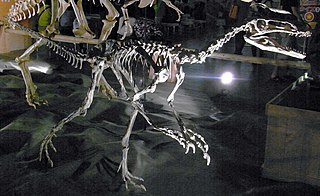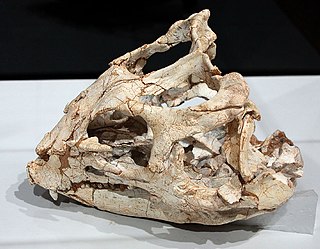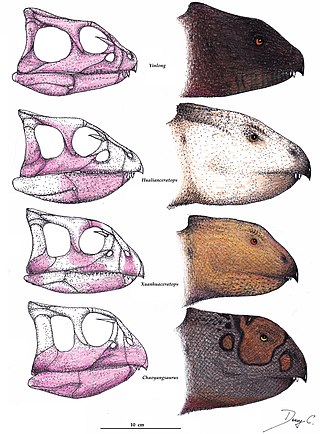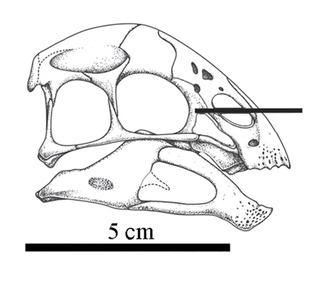
Alvarezsauridae is a family of small, long-legged dinosaurs. Although originally thought to represent the earliest known flightless birds, they are now thought to be an early diverging branch of maniraptoran theropods. Alvarezsaurids were highly specialized. They had tiny but stout forelimbs, with compact, bird-like hands. Their skeletons suggest that they had massive breast and arm muscles, possibly adapted for digging or tearing. They had long, tube-shaped snouts filled with tiny teeth. They have been interpreted as myrmecophagous, adapted to prey on colonial insects such as termites, with the short arms acting as effective digging instruments to break into nests.

Guanlong (冠龍) is a genus of extinct proceratosaurid tyrannosauroid dinosaur from the Late Jurassic of China. The taxon was first described in 2006 by Xu Xing et al., who found it to represent a new taxon related to Tyrannosaurus. The name is derived from Chinese, translating as "crown dragon". Two individuals are currently known, a partially complete adult and a nearly complete juvenile. These specimens come from the Oxfordian stage of the Chinese Shishugou Formation.

Bellusaurus was a small short-necked sauropod dinosaur from the Late Jurassic (Oxfordian) which measured about 4.8 metres (16 ft) long. Its fossils were found in Shishugou Formation rocks in the northeastern Junggar Basin in China.
Tugulusaurus is a genus of coelurosaurian theropod dinosaur that belongs to the Alvarezsauroidea. It is known from the Early Cretaceous Tugulu Group in the Urhe area of the People's Republic of China. It was one of the first members of Alvarezsauria ever discovered.

Kelmayisaurus is an extinct genus of carcharodontosaurid theropod dinosaur from the Early Cretaceous. It was roughly 10–12 meters long and its name refers to the petroleum-producing city of Karamay in the Xinjiang province of western China near where it was found.

Klamelisaurus is a genus of herbivorous sauropod dinosaur from the Middle Jurassic Shishugou Formation of China. The type species is Klamelisaurus gobiensis, which was named by Zhao Xijin in 1993, based on a partial skeleton discovered in 1982 near the abandoned town of Jiangjunmiao. Zhao described Klamelisaurus as the only member of a new subfamily, Klamelisaurinae, among the now-defunct primitive sauropod order Bothrosauropodoidea. Since Zhao's description, Klamelisaurus received limited attention from researchers until Andrew Moore and colleagues redescribed it in 2020.

Yinlong is a genus of basal ceratopsian dinosaur from the Late Jurassic Period of central Asia. It was a small, primarily bipedal herbivore.

Chaoyangsauridae is a family of ceratopsian dinosaurs. They are among the earliest known marginocephalian dinosaurs, with remains dating to about 160 million years ago, during the Late Jurassic period. Members of this group had sharp beaks for snipping off leaves to eat, and a very small frill.
The Shishugou Formation is a geological formation in Xinjiang, China.

Ceratonykus is a monospecific genus of alvarezsaurid dinosaur from Mongolia that lived during the Late Cretaceous in what is now the Barun Goyot Formation. The type and only species, Ceratonykus oculatus, is known from a fragmentary skeleton, including an incomplete skull, of an adult individual. It was named and described in 2009 by Vladimir Alifanov and Rinchen Barsbold. Its describers questioned the traditional placement of alvarezsaurs in Theropoda, instead suggesting they were ornithischians, but this has not been accepted since. Ceratonykus has an estimated length of 75 centimetres and weight of 760 grams. It has been considered as a possible junior synonym of Parvicursor.

Haplocheirus is a genus of theropod dinosaur. Upon its description, it was considered the oldest alvarezsauroid, predating all other members by about 63 million years. This has subsequently been questioned. A 2019 study considered Haplocheirus a compsognathid instead of an alvarezsauroid, while a 2022 study considered it to have more similarities with ornithomimosaurs. Haplocheirus was described in 2010 from a fossil specimen found from the 160-million-year-old Shishugou Formation in the Junggar Basin of northwestern China. The type species is H. sollers, meaning "skillful one", references its hypothesized behavior of using its three-fingered hands for activities that other alvarezsauroids could not perform, such as catching prey.

Alvarezsauroidea is a group of small maniraptoran dinosaurs. Alvarezsauroidea, Alvarezsauridae, and Alvarezsauria are named for the historian Gregorio Álvarez, not the more familiar physicist Luis Alvarez, or his son geologist Walter Alvarez who jointly proposed that the Cretaceous–Paleogene extinction event was caused by an impact event. The group was first formally proposed by Choiniere and colleagues in 2010, to contain the family Alvarezsauridae and non-alvarezsaurid alvarezsauroids, such as Haplocheirus, which is the basalmost of the Alvarezsauroidea. The discovery of Haplocheirus extended the stratigraphic evidence for the group Alvarezsauroidea about 63 million years further in the past. The division of Alvarezsauroidea into the Alvarezsauridae and the non-alvarezsaurid alvarezsauroids is based on differences in their morphology, especially in their hand morphology.

Zuolong is an extinct genus of tetanuran theropod from the Late Jurassic period of China. The type and only species is Z. salleei. The generic name of Zuolong is in honor of General Zu Zōngtáng with the Chinese word "long" which means dragon. The specific epithet "salleei" is in honor of Hilmar Sallee, who funded the expedition which led to the specimen's discovery.
Bonapartenykus is a monospecific genus of alvarezsauroid dinosaur from Argentina that lived during the Late Cretaceous (Campanian-Maastrichtian) in what is now the upper Allen Formation of the Río Negro Province. The type and only species, Bonapartenykus ultimus, is known from a nearly articulated but partial skeleton that was found in close association to two incomplete eggs and several clusters of eggshells belonging to the oogenus Arriagadoolithus. Bonapartenykus was named in 2012 by Federico L. Agnolin, Jaime E. Powell, Fernando E. Novas and Martin Kundrát. Bonapartenykus has an estimated length of 2.5 m (8.2 ft) and weight of 72 kg (159 lb), making it the largest member of the clade Alvarezsauroidea.

Yulong is an extinct genus of derived oviraptorid theropod dinosaur known from the Late Cretaceous Qiupa Formation of Henan Province, central China. It contains a single species, Yulong mini. It is known from many juvenile specimens that represent some of the smallest known oviraptorids and also a single subadult specimen.

Aorun (pron.:"AW-roon") is an extinct genus of carnivorous theropod dinosaur first discovered in 2006, with its scientific description published in 2013. It is one of the oldest known coelurosaurian dinosaurs and is estimated to have lived ~161.6 million years ago during the Late Jurassic Period. It is the fifth theropod discovered from Wucaiwan, China.

Bannykus is an alvarezsaur from the Early Cretaceous of the Bayin-Gobi Formation of Inner Mongolia, China. It includes one species, Bannykus wulatensis. It is large for an alvarezsaur, with an estimated weight of 24 kg based on femoral circumference.

Xiyunykus is an alvarezsaur from the Early Cretaceous of the Tugulu Group of China. It includes one species, Xiyunykus pengi.
Fushanosaurus is a genus of sauropod dinosaur from the Shishugou Formation from Xinjiang Province in China. The type and only species is Fushanosaurus qitaiensis. It is solely known from the holotype specimen FH000101, a complete right femur.

Aratasaurus is a monotypic genus of basal coelurosaurian theropod which includes a single species, Aratasaurus museunacionali, known from fossils found in deposits of the Romualdo Formation in Brazil. Aratasaurus lived during the Albian stage of the Early Cretaceous.

































